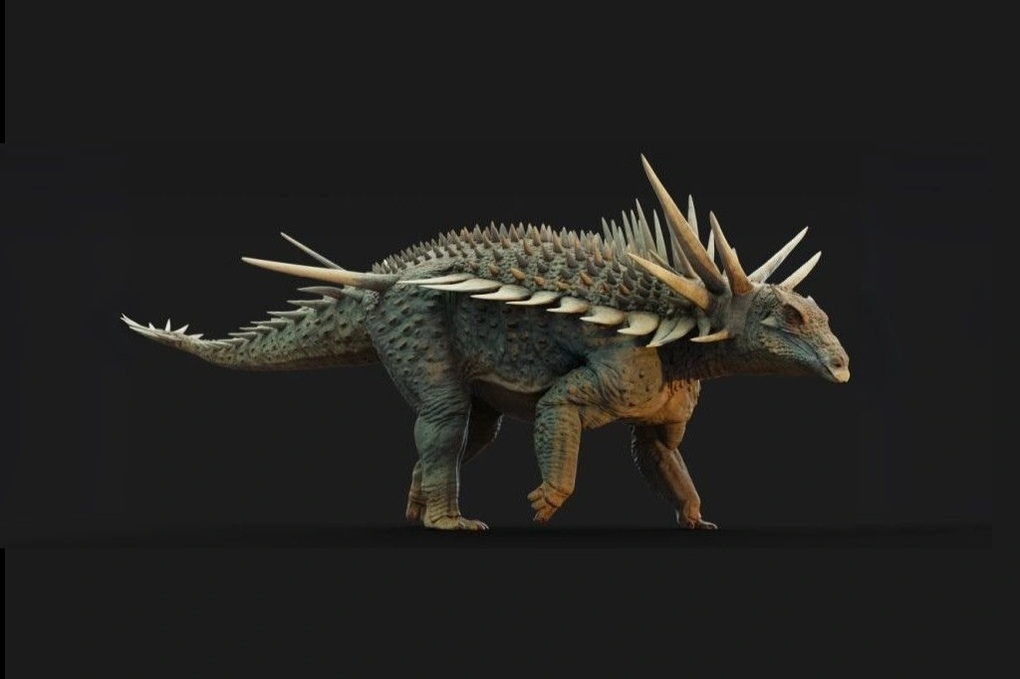A newly excavated dinosaur fossil in Morocco is surprising scientists around the world.
This dinosaur, scientifically named Spicomellus afer, possessed a strange set of spiked armor, never recorded in any animal, ancient or modern.

Recreating the appearance of the Spicomellus afer dinosaur with its thorny appearance (Photo: Science Alert).
Strange spiked armor challenges all evolutionary theories
Ankylosaur dinosaurs, a group of plant-eating dinosaurs known for their "living tank" appearance during the Jurassic and Cretaceous periods, are often known for their armored bodies and weapon-like tails. However, Spicomellus went far beyond what paleontologists had previously imagined of an ankylosaur.
Fossils show that this species' body was covered with large spines, up to nearly 1 meter long, attached to the ribs and hips. In particular, many spines grew into a ring of armor surrounding the neck and body, creating an appearance likened to a "prehistoric armored warrior".
Dr Susannah Maidment, an expert at the Natural History Museum in London, admitted: "I have studied many species of dinosaurs, but I have never seen such a bizarre structure."
It is debatable whether this armor actually served a defensive purpose, with many scientists arguing that the giant spikes probably had no combat value.
Instead, they may have been display tools similar to antlers or peacock feathers, used to attract mates or intimidate rivals. This suggests that ankylosaur may have used their "distinctive" appearance for communication and competition, not just to fend off predators.
Discovery changes the picture of dinosaur armor
According to Science Alert , the dinosaur Spicomellus afer lived about 165 million years ago, in the middle of the Jurassic period, at least 30 million years earlier than famous ankylosaur like Ankylosaurus in the late Cretaceous period.
This discovery challenges the long-held notion that armored dinosaurs evolved to become more practical and effective in defense. On the contrary, nature seems to have “tested” different strategies, and some species evolved more ostentatious armor.
It is likely that at that time, survival strategies in the wild were not only based on defensive strength, but may also have been shaped by interspecies communication and reproductive competition.
Professor Richard Butler from the University of Birmingham said: "No other animal, living or extinct, has spines attached to bones in this way. Spicomellus is truly an anomaly in natural history."
Source: https://dantri.com.vn/khoa-hoc/phat-hien-chan-dong-khung-long-giap-gai-nhon-thach-thuc-ly-thuyet-tien-hoa-20250828064048883.htm



![[Photo] Hanoi is ready to serve the occasion of the 80th National Day Celebration on September 2nd](https://vphoto.vietnam.vn/thumb/1200x675/vietnam/resource/IMAGE/2025/8/29/c838ac82931a4ab9ba58119b5e2c5ffe)
































![[Photo] Prime Minister Pham Minh Chinh meets with Speaker of the New Zealand Parliament Gerry Brownlee](https://vphoto.vietnam.vn/thumb/1200x675/vietnam/resource/IMAGE/2025/8/28/cec2630220ec49efbb04030e664995db)
































































Comment (0)